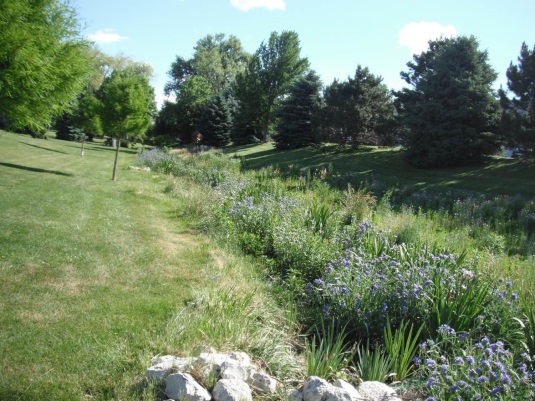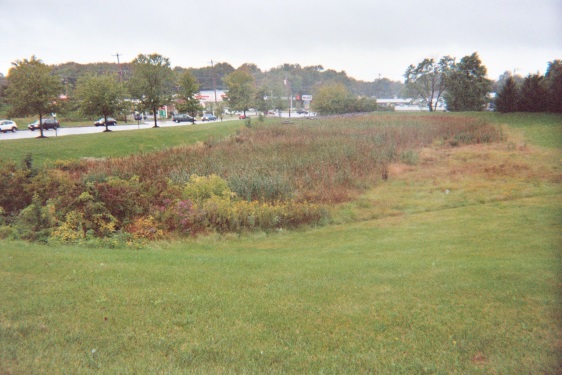4.7.6. SITE DESIGN FOR LOW IMPACT DEVELOPMENT – (LID).
A. General.
1. Treating and capturing storm water at the source is a proactive process. Traditional storm water management practices include the construction of large unattractive detention basins that are at the receiving end of a pipe located on public property and maintained by a public agency. Recently, the thought process has started to shift to more environmentally proactive practices that look at preventing storm water contaminants from entering the storm water conveyance system and or water body at the source rather than spending costly amounts of money retrofitting existing systems.
2. Today homeowners, developers, and local governments have opportunities to implement source control practices through the use of Low Impact Development (LID) options. These are typically located within a public right-of-way or on private property and are maintained by the property owner. A vegetated component is usually included that is directly tied to the treatment and infiltration functions. Plant selection is key to public perception and ultimately the acceptance of the integration of LID practices into the landscape.
B. Purpose.
1. To encourage the incorporation of low impact development standards (LIDs) into landscape designs in an effort to mitigate the impacts of increased runoff and storm water pollution from new development, redevelopment or infill developments close to the source as possible. LID practices are an integral part of the urban form and if designed and constructed correctly, will help ensure the preservation of permeable surfaces, encourage the use of native plants and promote infiltration into sub-soils to remove pollutants, regenerate ground water supplies and reduce subsidence rates.
2. The City acknowledges that project conditions associated with individual sites may justify approval of alternative methods of compliance when landscape is part of an integrated water management strategy or LID and the alternative proposal offers superior results. The standard landscape requirements may not be ignored or reduced by more than 35 percent in order to achieve the alternative. Planning staff will review the alternative design against standard landscape requirements and work with the applicant on a case-by-case basis to ensure compliance is achieved.
3. Applicants are encouraged to implement any of the following LID options at the time of site development. They are not intended to be prescriptive or inhibit creative design, but provide some ideas for consideration. Further descriptions and examples of Low Impact Development options that are permitted and promoted for use within the City are discussed in the Urban Drainage and Flood Control District Urban Storm Drainage Criteria Manual, Volume 3. By incorporating LIDs into parking lots, front yards and neighborhood streets, it becomes a tool to raise people’s awareness and change their behavior relative to reducing and cleaning storm water runoff.
C. Low Impact Development (LID) Options.
1. Bioswales are vegetated swales planted with wet tolerant species of plants or ornamental grasses. They transport, store, and allow infiltration of water and can be designed as a landscape feature. Bioswales are not grassed, but are planted with a variety of plant species that can withstand occasional water inundation for short periods of time.

2. Grassed swales are designed conveyance devices used to transport water over the surface of the ground to a point of disposal that may be a catch basin, ditch, water body that will filter, infiltrate, evaporate, and clean the water of total suspended solids, solid waste and other pollutants. Swales are often appropriate along property lines, public streets, and around buildings.


3. Permeable pavers, porous surfaces, grass paving. Pavers allow water seepage through the joints and through the graded gravel base that they are placed on. This allows for the infiltration of rainwater thereby reducing the runoff leaving a site. When used in connection with street tree plantings, they allow for more air circulation around tree roots and can easily be removed in order to trim tree roots and regrade for a walkable surface.

4. Rain gardens are small shallow, depressions planted with a variety of native or ornamental plants that can treat small amounts of runoff to improve water quality. Rain gardens are generally small collections of water loving plants planted on a low site area that naturally collects rainfall.


5. Sand filters are depressions, trenches, barriers, or sand lens constructed of porous mineral matter that improve ground water recharge to filter, clean and trap waterborne pollutants.
6. In addition, other LID standards include extended detention basins that may be used in open space tracts to treat the runoff from multiple lots, roads, trails, and pathways.

D. Reserved.
Editor’s note: The provisions of this subsection were repealed by Ord. 2023-41, enacted September 11, 2023.
(Ord. No. 2023-41 § 15, 09-11-2023; Ord. No. 2019-49 § 1, 08-19-2019)